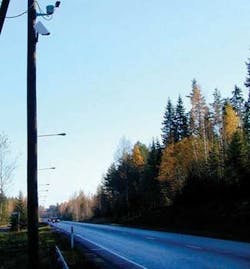ROAD MONITORING: Laser system monitors slipperiness of roadways

Scandinavian motorists have a new tool for detecting dangerous road conditions. A laser-based road-monitoring system bounces light from the road to a detector and can sense when roads are slippery (see figure).1 The information from the system can be used to inform maintenance crews when it is time to salt or plow the roads, or to provide immediate feedback to drivers via ectronic signs or radio as to the slipperiness of the roadway.
The DSC111 remote road-surface sensor was created by Vaisala Oyj (Helsinki, Finland) using lasers and transmitter optics from Modulight (Tampere, Finland and San Jose, CA) to obtain short-range spectroscopic measurements of the water and ice on a road surface. An infrared transmitter laser emits several wavelengths around 1.4 µm, a wavelength that corresponds to the absorption of water, according to Modulight’s Anca Guina. The beam is aimed at a wheel track at a horizontal angle of about 30° or higher from the road surface. The back-reflected light passes through a near-IR detector to measure the thickness of water and ice over time. The system, which uses about 2 W of power, can distinguish between the specific wavelengths of water and ice, and is thus able to differentiate between frost, snow, slush, and black ice on the road surface.
Road surfaces can become slippery with ice layers of approximately 30 µm, which the DSC111 can detect. However, the amount of ice alone does not predict slipperiness. The DSC111 detects water and ice independently to build a realistic slipperiness index called “grip.” Using actual friction measurements, this index is based on the difference in grip between a dry road (0.8) and the most slippery conditions (less than 0.1).
According to Taisto Haavasoja, R&D manager at Vaisala Oyj, 200 units have been delivered so far, mostly to Finland, Sweden, and Denmark, but they might also be spotted soon beside roadways in the U.S., England, Ireland, and Germany.
REFERENCES
1. Y. Pilli-Sihvola et al., Proc. SIRWEC Torino, (2006).
About the Author
Valerie Coffey-Rosich
Contributing Editor
Valerie Coffey-Rosich is a freelance science and technology writer and editor and a contributing editor for Laser Focus World; she previously served as an Associate Technical Editor (2000-2003) and a Senior Technical Editor (2007-2008) for Laser Focus World.
Valerie holds a BS in physics from the University of Nevada, Reno, and an MA in astronomy from Boston University. She specializes in editing and writing about optics, photonics, astronomy, and physics in academic, reference, and business-to-business publications. In addition to Laser Focus World, her work has appeared online and in print for clients such as the American Institute of Physics, American Heritage Dictionary, BioPhotonics, Encyclopedia Britannica, EuroPhotonics, the Optical Society of America, Photonics Focus, Photonics Spectra, Sky & Telescope, and many others. She is based in Palm Springs, California.
